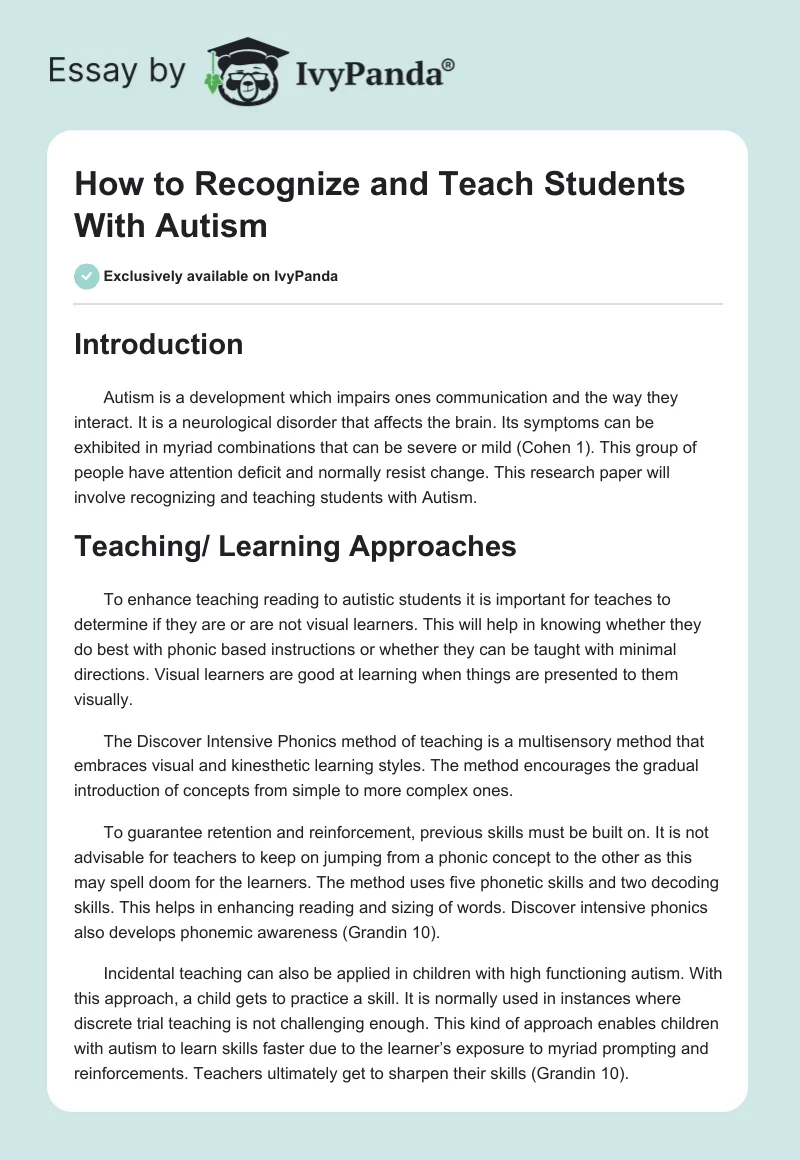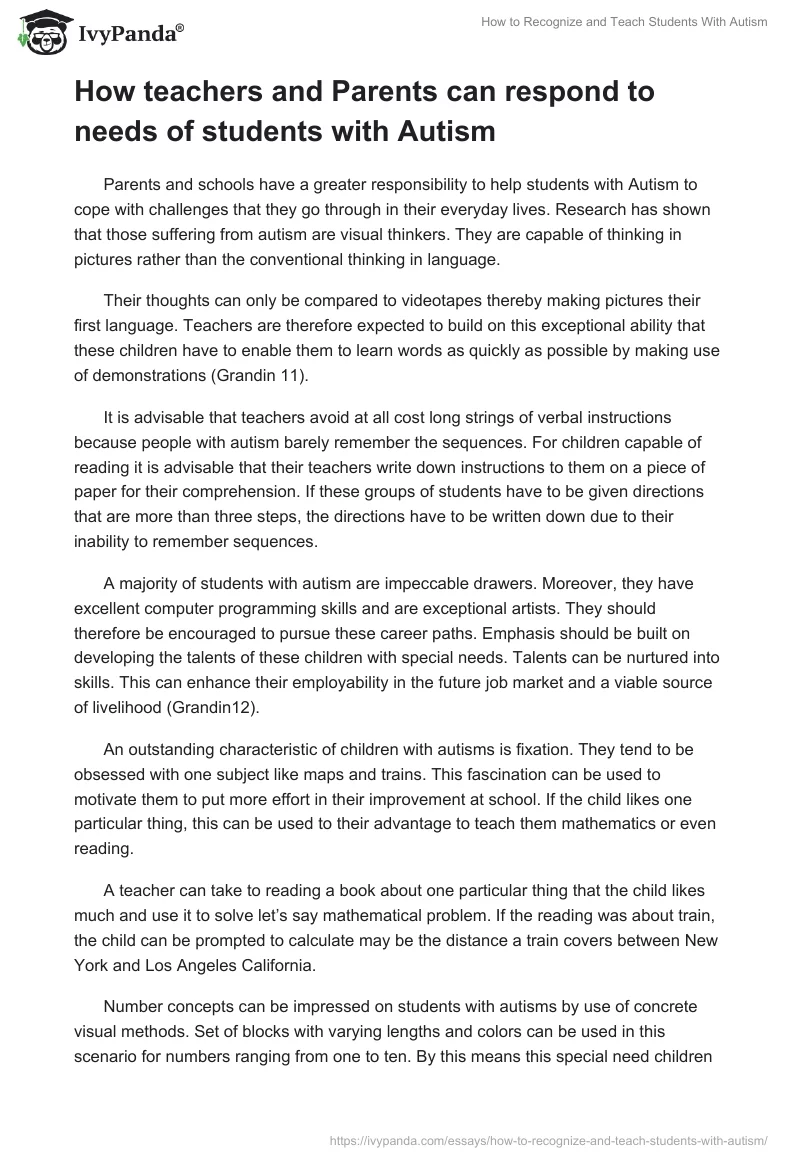Introduction
Autism is a development which impairs ones communication and the way they interact. It is a neurological disorder that affects the brain. Its symptoms can be exhibited in myriad combinations that can be severe or mild (Cohen 1). This group of people have attention deficit and normally resist change. This research paper will involve recognizing and teaching students with Autism.
Teaching/ Learning Approaches
To enhance teaching reading to autistic students it is important for teaches to determine if they are or are not visual learners. This will help in knowing whether they do best with phonic based instructions or whether they can be taught with minimal directions. Visual learners are good at learning when things are presented to them visually.
The Discover Intensive Phonics method of teaching is a multisensory method that embraces visual and kinesthetic learning styles. The method encourages the gradual introduction of concepts from simple to more complex ones.
To guarantee retention and reinforcement, previous skills must be built on. It is not advisable for teachers to keep on jumping from a phonic concept to the other as this may spell doom for the learners. The method uses five phonetic skills and two decoding skills. This helps in enhancing reading and sizing of words. Discover intensive phonics also develops phonemic awareness (Grandin 10).
Incidental teaching can also be applied in children with high functioning autism. With this approach, a child gets to practice a skill. It is normally used in instances where discrete trial teaching is not challenging enough. This kind of approach enables children with autism to learn skills faster due to the learner’s exposure to myriad prompting and reinforcements. Teachers ultimately get to sharpen their skills (Grandin 10).
How teachers and Parents can respond to needs of students with Autism
Parents and schools have a greater responsibility to help students with Autism to cope with challenges that they go through in their everyday lives. Research has shown that those suffering from autism are visual thinkers. They are capable of thinking in pictures rather than the conventional thinking in language.
Their thoughts can only be compared to videotapes thereby making pictures their first language. Teachers are therefore expected to build on this exceptional ability that these children have to enable them to learn words as quickly as possible by making use of demonstrations (Grandin 11).
It is advisable that teachers avoid at all cost long strings of verbal instructions because people with autism barely remember the sequences. For children capable of reading it is advisable that their teachers write down instructions to them on a piece of paper for their comprehension. If these groups of students have to be given directions that are more than three steps, the directions have to be written down due to their inability to remember sequences.
A majority of students with autism are impeccable drawers. Moreover, they have excellent computer programming skills and are exceptional artists. They should therefore be encouraged to pursue these career paths. Emphasis should be built on developing the talents of these children with special needs. Talents can be nurtured into skills. This can enhance their employability in the future job market and a viable source of livelihood (Grandin12).
An outstanding characteristic of children with autisms is fixation. They tend to be obsessed with one subject like maps and trains. This fascination can be used to motivate them to put more effort in their improvement at school. If the child likes one particular thing, this can be used to their advantage to teach them mathematics or even reading.
A teacher can take to reading a book about one particular thing that the child likes much and use it to solve let’s say mathematical problem. If the reading was about train, the child can be prompted to calculate may be the distance a train covers between New York and Los Angeles California.
Number concepts can be impressed on students with autisms by use of concrete visual methods. Set of blocks with varying lengths and colors can be used in this scenario for numbers ranging from one to ten. By this means this special need children can learn to add and subtract. A wooden tennis ball cut into four pieces and a wooden mango cut into half, for instance, can be used to introduce the children to working with fractions. This is very important in introducing to them issues to do with quarters and halves.
Some children with autism do not have the best handwriting because of issues pertaining to motor control of their hands. They perpetually struggle to have the best handwritings and this has remained a mirage to most of them. They are so upset about this. To boost these children’s morale, they can be encouraged to be typing on the computer which is relatively easier.
It is easy for Autistic children to learn reading by using phonics or by memorizing words. The parents can help their children by introducing them to the rules of phonics.
This enhances their capability of sounding out their words. Flash cards and picture books are the appropriate learning avenues for autistic children with echolalia. These help them associate whole words with pictures. When teaching nouns, teaches have to talk while looking at pictures and printed words. The teacher has to demonstrate by undertaking to do the specific activity when he or she teaches verbs.
Certain sounds are so outrageous to children with autism. Autistic students should learn in environment free of sounds that hurt their eyes. It is likely that such students will stuff their ears with tissues or duct tapes when they hear the sounds of school bell or buzzers. School administration should ensure that they install carpet or use material that would prevent sound of scraping chairs from antagonizing these special need children.
A child may develop fear for certain school facilities because of these sounds. This enhances bad behavior in them. Teachers have to be sensitive to these children sources of discomfort. When they are seen covering their eyes, this should be taken to mean that their eyes are being hurt by sound (Ministry of Education-Special Programs Branch par.1).
To remedy distractions occasioned by flickering fluorescent lights, desks of autistic children should be placed next to windows or alternatively fluorescent lights can be done away with. If this is not possible it is advisable that newest bulbs are made use of because they flicker less.
Padded weighted vests can be used by students with hyperactive autism. Such children who characteristically fidget at the slightest opportunity will be calm if they are subjected to the use of such devices. The pressure from the padded weighted vests has the advantage of calming the nervous system hence the children’s concentration in class.
Teachers should critically examine children with autism and ascertain their unique features. They should avoid using blanket approaches to meet each of their needs.
Some people with autism have enviable prowess in singing than in speaking. Such category of children with special needs tend to respond well when words are sung to then than they are spoken. They will therefore learn and respond well if teachers talked to them in hushed tones or low whispers.
Some autistic nonverbal children find it extremely hard to process visual and auditory input simultaneously because they are mono-channel. This makes it hard for them to see and hear at the same time and should not be compelled to do that. They should be assigned tasks that either involves seeing or hearing but not both.
Their nervous system is considered immature and cannot process this information simultaneously. Older nonverbal autistic children have very sensitive to touch. They can therefore be taught by use of plastic letters that they can feel.
To enhance faster learning in those students with autism who can effectively use computer when the key board is placed next to the monitor, they should be allowed to use them simultaneously. This will curtail problems related to recalling that arise when they have to look up after striking a key on the key board.
Printed words and pictures on flash cards should be used in teaching nonverbal autistic children. They find it relatively easy to associate words and pictures when such aids are used. For those of them who find it difficult to do line drawings, objects and photos should be used in teaching them.
Some autistic children are not aware that a speech is a conduit for communication. To promote communication in children unaware that speeches are a means to communication, they should be taught more on language learning. Exercises on this should be the number one priority of teachers.
For instance, if a child asks for an eraser, they should be given exactly that. If a child asks for a pen when he or she in actual sense needs a pencil, give him or her pencil. Such individuals have to come to a realization that utterances are ensued by concrete actions.
Children with autism find it difficult to manipulate computer mouse. They should be taught more on how well they can handle the computer mouse. This problem with holding mouse button can be attributed to motor control problems.
Learning to read can also be enhanced by recording the students’ favorite programs with captions.
Irlen colored glasses should be used by autistic children who have phobia for escalators because they cannot determine when to climb on or off. Such people have visual processing problems similar to that brought about by flicker of fluorescent lights.
Autistic children with visual processing inabilities should be encouraged to use colored papers whenever they want to print black fonts to help reduce contrast. However, bright yellow papers should be avoided. Iren colored glasses can also be used for reading. Teaching generalization can pose a potential danger to children with autism because they will imagine that what they were taught is applicable in all circumstances.
Children with autism tend to use small non-relevant detail to recognize detail. Teachers should therefore labor to find out what this detail may be. This will help them in putting up with those individuals who use toilet correctly at home but cannot replicate this to school situation.
Children with severe autism find it extremely hard to sequence and comprehend tasks presented one after the other. In fact, nonverbal autistic children can be taught how to use playground slide by walking up the climbing ladder and finally going down the slide (Middlemiss 1).
Emphasis has to be put on touch and motor than visually experimentation. For those children with fussy eating habit which is a common problem, different but similar food can be put in their cereal boxes containing their favorite food (Special Education Unit, par. 1).
Conclusion
Teachers should make it a practice of doing homework about autism before students with autisms join their classes. This will help them in understanding the child wholly. They should speak to the child’s family and their previous teachers to know what such children are sensitive to and what comforts them. The teachers should appreciate that they can’t relate to importance of such things the way the child with autism does. Teachers should also learn to embrace change. This will help them adjust their lessons when there is need.
Works Cited
Cohen, Simon. Targeting autism: What we know, don’t know, and can do to help Young children with autism and related disorders. California: University at California Press, 1998. Print.
Grandin, Tobias. Thinking in pictures and other reports from my life with autism. New York: Random House, 1995. Print.
Ministry of Education-Special Programs Branch. “Teaching Students with Autism: A Resource Guide for Schools.” British Columbia (2000).
Middlemiss, Elizabeth. Reaching and Teaching Children with Autism Spectrum Disorders. Department of Defense Education Activity (2002).
Special Education Unit. Teaching Students with Autism: A Guide for Educators New York: Random House, 1999. Print.


